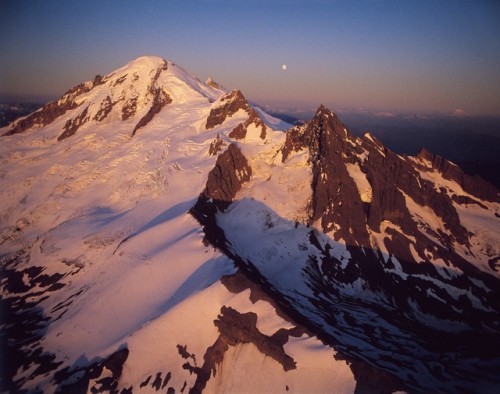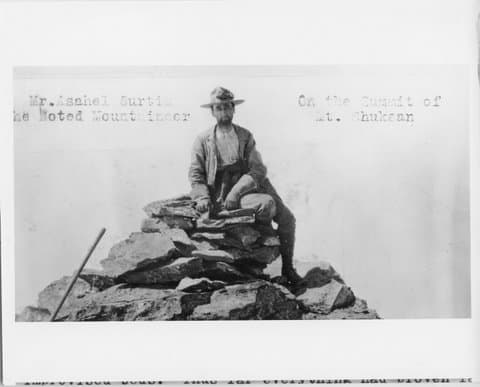Koma Kulshan

John Miles will read from his book Koma Kulshan at Village Books on Sat, May 1, at 7 pm. Photo by Brett Baunton.
Mount Baker was officially named by George Vancouver for Lieutenant Joseph Baker of the good ship Discovery who directed his captain’s attention to the dominant white peak on the eastern horizon in 1792. Discovery had dropped anchor in Dungeness Bay on the northeast shore of the Olympic Peninsula. Vancouver was impressed, and since he was naming everything encountered on his historic voyage, honored his lieutenant by attaching his name to this great peak. Thus did this mountain come to bear the name of an otherwise obscure British naval officer.
Native people had various names for the peak, but to early white man’s ears the name spoken by the Nooksack people seemed to be “Koma Kulshan†which, they thought, must be the Indian name for the great peak – but it was not. The phrase kwomae klelsaen can be translated “go up high or way back in the mountains shooting.†So, the phrase which sounded like “koma Kulshan†to the white ear referred to the region of the mountain, not the mountain itself. My book, Koma Kulshan: The Story of Mount Baker, takes the Indian meaning and tells tales of the mountain and the region around it.
I am delighted to have a new edition of Koma Kulshan hot off the press after more than two decades. The original research and writing of this book, which was my first, occurred in the late 1970s and early 1980s, with publication by The Mountaineers in 1984. It sold well, but went out of print around 1990. For many years I hoped to revise and reissue it, but the publisher had moved on to other priorities, so it languished. Then, in the summer of 2009, Chuck Robinson of Village Books, the great independent bookstore in Bellingham, approached me with an idea.
Chuck is an extraordinary entrepreneur and is always trying (with success) to keep his independent bookstore flourishing in this age of on-line and big-box bookstores. He was thinking of going into the publishing-on-demand business by installing an Espresso publishing machine in the store. Would I be interested in publishing my two North Cascades books (the other is my edited Impressions of the North Cascades) this way? I would and we have done it. Impressions became available in late fall, and Koma Kulshan in March.
Initially we thought we could just scan the original books and produce facsimile editions, but this was not possible with Koma Kulshan. It needed to be updated, which I did, and scans of the more than 100 photographs, most of them historic, did not come out well. So I rewrote the last couple of chapters to bring them up to date and my friend Susan Morgan tracked down nearly all of the old photographs, photo archivist extraordinaire Jeff Jewell of the Whatcom Museum scanned them, and with the help of book designer Kate Weisel, the revised book came together. You can now go to Village Books and watch the book come literally “hot†off the press (see embedded video at end of post). Koma Kulshan takes a bit over 8 minutes to print, and it is warm when you pick it up. A new era of small-scale publishing has dawned.

The book is full of stories about early explorers, prospectors, and climbers like Edmund Coleman, John Tennant, Victor Lowe, Ed Cooper, and Fred Beckey. It describes the incredible episode of the Mount Baker Marathons of 1911-13. The tragedy of the 1939 Western Washington College of Education (now WWU) climb in which six students lost their lives is chronicled along with other misadventures. Mount Baker lies within a national forest and is mostly congressionally designated wilderness but was promoted many times for national park status. The long history of the debate over its “management†is sprinkled throughout the stories of climbs, prospects, and recreational developments.
The principal change in this edition from the original is the account of what has happened regarding allocation of the area over the past twenty years. Much of the Mountain was added to the National Wilderness Preservation System. A wedge on the south side up to Sherman Crater was reserved for snowmobilers at the Mount Baker National Recreation Area. Concern about loss of biodiversity raised attention to the Northern Spotted Owl and stopped timber harvest, which had been one of the major uses of the area. The final chapter includes my speculations about what the future might hold.
I love this mountain. It is the symbol for me of one of the world’s greatest landscapes – the North Cascades. I’ve been blessed to be able to trace its story, following in the literal footsteps of another Mount Baker fanatic, Charles Finley Easton, for whom the Easton glacier is named. Who was Easton? I will tell his story, among others, on May 1 at Village Books, complete with slides. Mount Baker fans — come one, come all!
More about Village Books’ unique Espresso Book Machine that is bringing John’s out-of-print works back to life:
[vimeo]http://vimeo.com/7423520[/vimeo]


